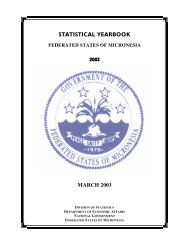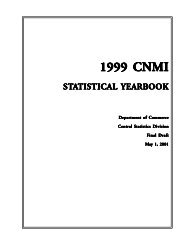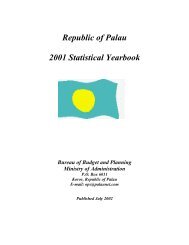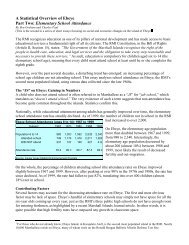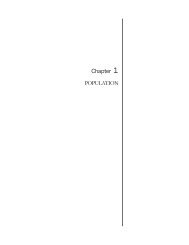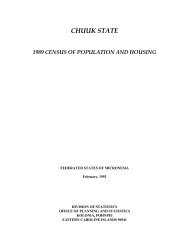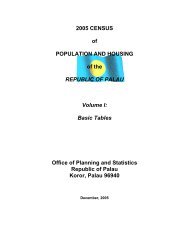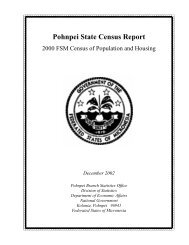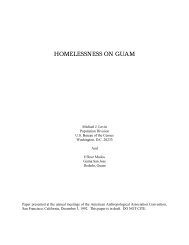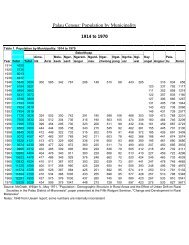Chapter 4. Fertility2000 FSM <strong>Census</strong> of <strong>Chuuk</strong> <strong>State</strong>For the 2000 census data on births were reported by women of reproductive ages in the year before the census, a CBRof 27.5 per 1,000 (1,471 births divided by an estimated mid-period population of 53,570 and multiplied by 1,000).However, this is likely to be an under count in view of the estimate derived from the second method.The second method is based on reverse survival (United Nations, 1967). This estimate considers that the childrencounted in the census below 1 year of age, were born in the year before the census. The method also recognizes thatsome babies born during this year died before the census was taken. Once these "deaths" have been added to thechildren counted in the census, an estimate of births during the year is obtained. It is further assumed that the effects ofmigration on the estimates of births are negligible (migration data suggest that for children below age 15, thisassumption is reasonable).Using the survivorship ratios and the population counted in the census aged zero, we find the CBR (Table 4.1). Thesurvivorship ratio permits the estimation of children who have died before the census. Survivorship ratios have beenselected from model life tables (Coale-Demeny West level 20 — for calculation see Chapter 5 on mortality), which arerequired since the birth and death civil registration systems in the <strong>State</strong> of <strong>Chuuk</strong> are not complete. In theory, thesurvivorship ratios are intended to calculate survivors forward to a later age, while here, we are surviving thembackward in time to estimate the number of births; hence the term "reverse survival". To calculate the number of birthsin the year, the number of persons enumerated in the census aged 0 to 1 (row 1) is divided by the survivorship ratio(row 2). It is then necessary to estimate the mid-period population. The earlier mid-period population was estimatedusing the approximate annual growth rate. For the 1994 and 2000 <strong>Census</strong>es the rates were 2.2 and .1 percent,respectively. As the last row shows, the CBR using reverse survival for April 2, 1999 to April 1, 2000 is 27.5 per1,000.Table 4.1: Crude Birth Rate, <strong>Chuuk</strong> <strong>State</strong>: 1994 and 2000Characteristics 1993-1994 1999-2000Population age zero 1,627 1,422Survivorship ratio 0.9626 0.9667Estimated births 1,689 (1993-1994) 1,471 (1999-2000)Mid-period population 52,736 53,570CBR 32 (1993-1994) 27.5 (1999-2000)Source: 1994 FSM <strong>Census</strong>, Table P15 and unpublished data; 2000 FSM <strong>Census</strong>, Table P2-4 and unpublished data.Note: Figure in parenthesis ( ) refers to the reference yearThe same procedure was used for 5-year periods going back 15 years before the census. The estimated CBR are givenin Table 4.2. The table reveals a great deal about fertility in the <strong>State</strong> of <strong>Chuuk</strong>. For the most recent period covered inthe above table, 1995-2000, the CBR is about 29 per thousand populations. Although this rate is high, the trend shownsuggests a moderately declining fertility. In the period 1985-90, about sixteen years before the 2000 <strong>Census</strong>, the CBRwas 36.1. In the sixteen-year interval from that time to the most recent period 1995-2000, fertility declined by about 21percent. The rate from the year before the census was 27.5 percent. Note that this is lower than the most recent fiveyearrate, showing that the fertility decline observed has probably continued during the five years before the census.Table 4.2: Estimation of Crude Birth Rate, <strong>Chuuk</strong> <strong>State</strong>: 1985 to 2000.Years in <strong>Census</strong> Survivorship Estimated births Mid-period CrudeAge groups which born population ratio since birth in 5-year period population birth rateLess than 5 years 1995-2000 7,347 0.9559 7,686 53,470 28.75 to 9 years 1990-1995 7,305 0.9471 7,713 48,061 32.110 to 14 years 1985-1990 7,356 0.9430 7,801 43,199 36.1Source: 2000 FSM <strong>Census</strong>, 4unpublished data and Table P2-4.Note: Survivorship ratio is the life table probability of surviving from birth to the age groups specified and is approximately equivalent to the average probability ofsurviving from birth during the period specified to the time of the census.Table 4.3 further presents the CBRs as compiled from registration statistics obtained from the Department of Health,for comparison purposes. The registration lacked completeness, and the coverage was not consistent over the years.The CBRs obtained from the 1999 registration, for example, seems to have covered only about 77 percent of the births.The coverage was the lowest in the FSM (see 2000 FSM census reports for Kosrae, Pohnpei and Yap).36 <strong>Chuuk</strong> Branch Statistics Office, Division of Statistics, FSM Department of Economic Affairs
2000 FSM <strong>Census</strong> of <strong>Chuuk</strong> <strong>State</strong>Chapter 4. FertilityTable 4.3: Registered Births by Calendar Year and Implied Crude Birth Rate, <strong>Chuuk</strong> <strong>State</strong>: 1992 to 1999Index 1992 1993 1994 1995 1996 1997 1998 1999Registered births 1,108 1,157 1,139 1,094 1,044 1,101 1,160 1,138Implied crude birth rate (CBR) 21.8 22.3 21.6 20.5 19.6 20.6 21.7 21.3Source: Department of Health Services, FSM, unpublished dataAs long as the assumptions made in choosing the life table and in selecting a rate of growth are reasonable, the errors infertility estimates, resulting from the lack of better data, will be small. The principal merits of the CBR as a measureof fertility are its relative simplicity and its interpretation as a direct contribution to the rate of natural growth.However, the CBR in relation to the total population tells little about the fertility of women neither at reproductive agesnor about the age structure of childbearing. We must be very careful in using CBR for comparison. The CBRestimates are dependent on the age structure of a population. As a result, unless standardized, they will not becomparable over time or across regions with different age structures. Fortunately, the census data do enable us tomeasure fertility in more detail.Age-Specific FertilityTo look at the recent age structure of births, the age groups of mothers can classify children born in the past year. Thistabulation enables the calculation of age specific fertility rates (ASFR), that is, the average number of children born toeach woman in an age group during the year. Relating fertility experience to age provides a more detailed descriptionof fertility behavior or family formation, and provides a control of changes in age structure for comparative purposes.This report provides two methods for calculating and adjusting ASFRs. One involves reverse survival of births and theother involves comparing current fertility to previous fertility to check for under counting. The reverse survival methodis discussed first.Before producing age specific rates through reverse survival, the number of births in the past year reported by womenwas adjusted (see Table 4.1). This type of question is often under-reported and considerable care is needed for theresults to be usable. Consider, for example, the 1,471 estimated births for the year 1999-2000 based on reverse survivaland shown in Table 4.1. Assuming that the effects of migration for infants below one year were moderate anddiscrepancies arising from multiple births and maternal deaths were negligible, the response to the question elicitinginformation on births in the past year should be the same, or at least very close. As Table 4.4 shows, the total numberof women reporting a birth in the past year was 1,393, considerably lower than the estimated 1,471 derived from usingreverse survival.In order to correct for the under count, an adjustment factor is calculated by dividing the estimated births from reversesurvival by the reported number of births. In this case, it would be 1,637 estimated births divided by 1,393 reportedbirths resulting in an adjustment factor of 1.06 (see Table 4.4). The adjustment factor is then applied to the births tocorrect for the under count.Table 4.4: Adjustment of Births in Year Prior to the <strong>Census</strong>, <strong>Chuuk</strong> <strong>State</strong>: 1994 and 20001994 2000Number <strong>Report</strong>ed Unadjusted Adjusted Adjusted Number <strong>Report</strong>ed Unadjusted Adjusted AdjustedAge groups of women births ASFR births ASFR of women births ASFR births ASFRTotal 11,852 1,417 ... 1,689 ... 13,061 1,393 ... 1,471 ...15 to 19 years 2,855 75 0.026 89 0.031 3,343 93 0.028 98 0.02920 to 24 years 2,214 280 0.126 334 0.151 2,270 316 0.139 334 0.14725 to 29 years 1,708 332 0.194 396 0.232 2,032 380 0.187 401 0.19730 to 34 years 1,605 325 0.202 387 0.241 1,571 288 0.183 304 0.19435 to 39 years 1,426 228 0.160 272 0.191 1,451 199 0.137 210 0.14540 to 44 years 1,197 143 0.119 170 0.142 1,293 91 0.070 96 0.07445 to 49 years 847 34 0.040 41 0.048 1,101 26 0.024 27 0.025TFR ... ... 4.35 ... 5.18 … … 3.84 … 4.06Source: 1994 FSM <strong>Census</strong>, Table P15; 2000 FSM <strong>Census</strong>, Table P2-3.Note: Adjustment factor equals total births (reverse survival) divided by the number of women reporting a birth in the past year.<strong>Chuuk</strong> Branch Statistics Office, Division of Statistics, FSM Department of Economic Affairs 37
- Page 5:
iii
- Page 12 and 13:
Preface2000 FSM Census of Chuukx
- Page 14 and 15: Table of contents2000 FSM Census of
- Page 16 and 17: LIST OF TEXT TABLESTABLEPageChapter
- Page 18 and 19: List of Text Table2000 FSM Census o
- Page 20 and 21: LIST OF FIGURESFIGUREPageFigure 1.1
- Page 22 and 23: List of Basic-Tables2000 FSM Census
- Page 24 and 25: MAP OF FSMxxiiChuuk Branch Statisti
- Page 27 and 28: 2000 FSM Census of Chuuk StateExecu
- Page 29 and 30: CHAPTER 1INTRODUCTIONThe creation o
- Page 31 and 32: 2000 FSM Census of Chuuk StateChapt
- Page 33 and 34: 2000 FSM Census of Chuuk StateChapt
- Page 35 and 36: 2000 FSM Census of Chuuk StateChapt
- Page 37 and 38: 2000 FSM Census of Chuuk StateChapt
- Page 39 and 40: 2000 FSM Census of Chuuk StateChapt
- Page 41 and 42: 2000 FSM Census of Chuuk StateChapt
- Page 43 and 44: 2000 FSM Census of Chuuk State Chap
- Page 45: 2000 FSM Census of Chuuk StateChapt
- Page 48 and 49: Chapter 2. Age and Sex Structure200
- Page 50 and 51: Chapter 2. Age and Sex Structure200
- Page 52 and 53: Chapter 2. Age and Sex Structure200
- Page 55 and 56: CHAPTER 3HOUSEHOLDS, FAMILIES, AND
- Page 57 and 58: 2000 FSM Census of Chuuk StateChapt
- Page 59 and 60: 2000 FSM Census of Chuuk StateChapt
- Page 61: 2000 FSM Census of Chuuk StateChapt
- Page 66 and 67: Chapter 4. Fertility2000 FSM Census
- Page 68 and 69: Chapter 4. Fertility2000 FSM Census
- Page 71 and 72: CHAPTER 5MORTALITYIntroductionAs re
- Page 73 and 74: 2000 FSM Census of Chuuk StateChapt
- Page 75: 2000 FSM Census of Chuuk StateChapt
- Page 78 and 79: Chapter 6. Migration2000 FSM Census
- Page 80 and 81: Chapter 6. Migration2000 FSM Census
- Page 82 and 83: Chapter 6. Migration2000 FSM Census
- Page 84 and 85: Chapter 6. Migration2000 FSM Census
- Page 86 and 87: Chapter 7. Religion, Ethnicity, and
- Page 88 and 89: Chapter 7. Religion, Ethnicity, and
- Page 90 and 91: Chapter 7. Religion, Ethnicity, and
- Page 92 and 93: Chapter 8. Education2000 FSM Census
- Page 94 and 95: Chapter 8. Education2000 FSM Census
- Page 96 and 97: Chapter 8. Education2000 FSM Census
- Page 98 and 99: Chapter 8. Education2000 FSM Census
- Page 100 and 101: Chapter 8. Education2000 FSM Census
- Page 103 and 104: CHAPTER 9ECONOMIC ACTIVITYIntroduct
- Page 105 and 106: 2000 FSM Census of Chuuk StateChapt
- Page 107 and 108: 2000 FSM Census of Chuuk StateChapt
- Page 109 and 110: 2000 FSM Census of Chuuk StateChapt
- Page 111 and 112: 2000 FSM Census of Chuuk StateChapt
- Page 113 and 114: 2000 FSM Census of Chuuk StateChapt
- Page 115 and 116:
2000 FSM Census of Chuuk StateChapt
- Page 117 and 118:
CHAPTER 10INDUSTRY AND OCCUPATIONIn
- Page 119 and 120:
2000 FSM Census of Chuuk StateChapt
- Page 121 and 122:
2000 FSM Census of Chuuk StateChapt
- Page 123 and 124:
2000 FSM Census of Chuuk StateChapt
- Page 125 and 126:
2000 FSM Census of Chuuk StateChapt
- Page 127 and 128:
2000 FSM Census of Chuuk StateChapt
- Page 129 and 130:
CHAPTER 11INCOMEIntroductionThe 200
- Page 131 and 132:
2000 FSM Census of Chuuk StateChapt
- Page 133 and 134:
2000 FSM Census of Chuuk StateChapt
- Page 135 and 136:
2000 FSM Census of Chuuk StateChapt
- Page 137:
2000 FSM Census of Chuuk StateChapt
- Page 140 and 141:
Chapter 12. Housing2000 FSM Census
- Page 142 and 143:
Chapter 12. Housing2000 FSM Census
- Page 144 and 145:
Chapter 12. Housing2000 FSM Census
- Page 146 and 147:
Chapter 12. Housing2000 FSM Census
- Page 148 and 149:
Chapter 12. Housing2000 FSM Census
- Page 150 and 151:
Chapter 12. Housing2000 FSM Census
- Page 152 and 153:
Chapter 12. Housing2000 FSM Census
- Page 154:
Chapter 12. Housing2000 FSM Census
- Page 157 and 158:
BIBLIOGRAPHYArriaga, E.E., (1983).
- Page 159:
2000 FSM Census of Chuuk StateBibli
- Page 162 and 163:
Basic Tables2000 FSM Census of Chuu
- Page 164 and 165:
Basic Tables2000 FSM Census of Chuu
- Page 166 and 167:
Basic Tables2000 FSM Census of Chuu
- Page 168 and 169:
Basic Tables2000 FSM Census of Chuu
- Page 170 and 171:
Basic Tables2000 FSM Census of Chuu
- Page 172 and 173:
Basic Tables2000 FSM Census of Chuu
- Page 174 and 175:
Basic Tables2000 FSM Census of Chuu
- Page 176 and 177:
Basic Tables2000 FSM Census of Chuu
- Page 178 and 179:
Basic Tables2000 FSM Census of Chuu
- Page 180 and 181:
Basic Tables2000 FSM Census of Chuu
- Page 182 and 183:
Basic Tables2000 FSM Census of Chuu
- Page 184 and 185:
Basic Tables2000 FSM Census of Chuu
- Page 186 and 187:
Basic Tables2000 FSM Census of Chuu
- Page 188 and 189:
Basic Tables2000 FSM Census of Chuu
- Page 190 and 191:
Basic Tables2000 FSM Census of Chuu
- Page 192 and 193:
Basic Tables2000 FSM Census of Chuu
- Page 194 and 195:
Basic Tables2000 FSM Census of Chuu
- Page 196 and 197:
Basic Tables2000 FSM Census of Chuu
- Page 198 and 199:
Basic Tables2000 FSM Census of Chuu
- Page 200 and 201:
Basic Tables2000 FSM Census of Chuu
- Page 202 and 203:
Basic Tables2000 FSM Census of Chuu
- Page 204 and 205:
Basic Tables2000 FSM Census of Chuu
- Page 206 and 207:
Basic Tables2000 FSM Census of Chuu
- Page 208 and 209:
Basic Tables2000 FSM Census of Chuu
- Page 210 and 211:
Basic Tables2000 FSM Census of Chuu
- Page 212 and 213:
Basic Tables2000 FSM Census of Chuu
- Page 214 and 215:
Basic Tables2000 FSM Census of Chuu
- Page 216 and 217:
Basic Tables2000 FSM Census of Chuu
- Page 218 and 219:
Basic Tables2000 FSM Census of Chuu
- Page 220 and 221:
Basic Tables2000 FSM Census of Chuu
- Page 222 and 223:
Basic Tables2000 FSM Census of Chuu
- Page 224 and 225:
Basic Tables2000 FSM Census of Chuu
- Page 226 and 227:
Basic Tables2000 FSM Census of Chuu
- Page 228 and 229:
Basic Tables2000 FSM Census of Chuu
- Page 230 and 231:
Basic Tables2000 FSM Census of Chuu
- Page 232 and 233:
Basic Tables2000 FSM Census of Chuu
- Page 234 and 235:
Basic Tables2000 FSM Census of Chuu
- Page 236 and 237:
Basic Tables2000 FSM Census of Chuu
- Page 238 and 239:
Basic Tables2000 FSM Census of Chuu
- Page 240 and 241:
Basic Tables2000 FSM Census of Chuu
- Page 242 and 243:
Basic Tables2000 FSM Census of Chuu
- Page 244 and 245:
Basic Tables2000 FSM Census of Chuu
- Page 246 and 247:
Basic Tables2000 FSM Census of Chuu
- Page 248 and 249:
Basic Tables2000 FSM Census of Chuu
- Page 250 and 251:
Basic Tables2000 FSM Census of Chuu
- Page 252 and 253:
Basic Tables2000 FSM Census of Chuu
- Page 254 and 255:
Basic Tables2000 FSM Census of Chuu
- Page 256 and 257:
Basic Tables2000 FSM Census of Chuu
- Page 258 and 259:
Basic Tables2000 FSM Census of Chuu
- Page 260 and 261:
Basic Tables2000 FSM Census of Chuu
- Page 262 and 263:
Basic Tables2000 FSM Census of Chuu
- Page 264 and 265:
Basic Tables2000 FSM Census of Chuu
- Page 266 and 267:
Basic Tables2000 FSM Census of Chuu
- Page 268 and 269:
Basic Tables2000 FSM Census of Chuu
- Page 270 and 271:
Basic Tables2000 FSM Census of Chuu
- Page 272 and 273:
Basic Tables2000 FSM Census of Chuu
- Page 274 and 275:
Basic Tables2000 FSM Census of Chuu
- Page 276 and 277:
Basic Tables2000 FSM Census of Chuu
- Page 278 and 279:
Basic Tables2000 FSM Census of Chuu
- Page 280 and 281:
Basic Tables2000 FSM Census of Chuu
- Page 282 and 283:
Basic Tables2000 FSM Census of Chuu
- Page 284 and 285:
Basic Tables2000 FSM Census of Chuu
- Page 286 and 287:
Basic Tables2000 FSM Census of Chuu
- Page 288 and 289:
Basic Tables2000 FSM Census of Chuu
- Page 290 and 291:
Basic Tables2000 FSM Census of Chuu
- Page 292 and 293:
Questionnaire2000 FSM Census of Chu
- Page 294 and 295:
Questionnaire2000 FSM Census of Chu
- Page 296 and 297:
Questionnaire2000 FSM Census of Chu



